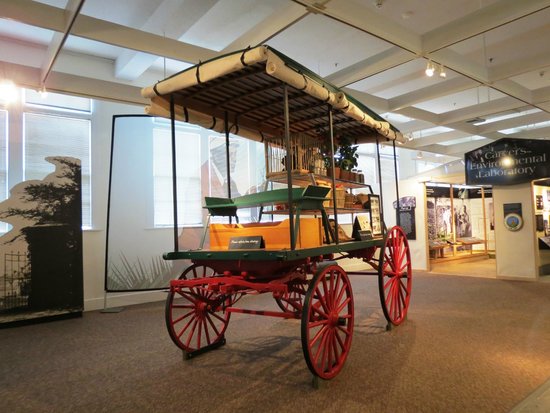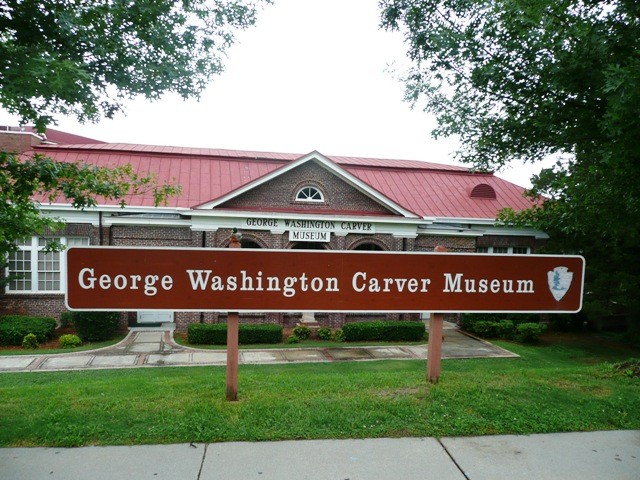The George Washington Carver Museum Tells a Very Interesting Story
The George Washington Carver Museum is a beautiful collection of books, exhibits, as well as a few films covering the life of this brilliant man.
This very interesting Museum is located at 1212 West Montgomery Road in Tuskegee Alabama, just north of old US highway 29.
 Vegetable Wagon at The George Washington Carver Museum
Vegetable Wagon at The George Washington Carver MuseumThis location makes it yet another of the Alabama backroads favorite destinations.
The George Washing Carver Museum was originally funded and developed by Henry Ford who wanted to fully display this man’s talents.
The History of the George Washington Carver Museum
 The Entrance to The George Washington Carver Museum
The Entrance to The George Washington Carver MuseumThis very talented man started life as a slave on the Moses Carver estate where his mother was a slave as well. He lived as a slave for the first 12 years of his life.
For more than 4 decades he labored at the Tuskegee Institute where he would paint pictures of plants, flowers, as well as landscapes.
In fact, several of his friends would later tell him he was literally obsessed with two things: improving the surroundings as well as the living conditions for rural and southern farm people.
The reason for this was simple, his upbringing as a slave.
His goal was to help as many people as he could, especially those that lived in the southern part of the country.
He was also obsessed with something else, extracting facts from nature through personal and scientific research.
Again, his goal was simple; find whatever benefit be could to make working with nature easier for mankind.
While he was given numerous honors throughout his lifetime, he often told his friends his biggest honor in life was the George Washington Carver Museum.
How the George Washington Carver Museum Came About
 The George Washington Carver Museum
The George Washington Carver MuseumThe museum itself came about as the result of the trustees of the Tuskegee Institute acting in 1938 at the request of the then president of the university, Fredrick D Patterson.
It had very humble beginnings, as it used to be the old laundry of the University.
However, once it was formerly setup, all of that changed.
In fact, it can be said that the George Washington Carver Museum was the first of its kind as it featured native plants of the south, as well as native birds and vegetables.
It also featured his own self-made products that included products from the sweet potato and the peanut.
It also featured his numerous paintings of nature as well as his drawings and textile art.
It was officially dedicated by Mr. and Mrs. Henry Ford in 1941 and sadly, Mr. Carver passed in January of 1943.
More tragedy stuck as in 1947 the museum itself was destroyed by a fire, but as luck would have it, very few of Mr. Carvers products were damaged.
Sadly however, most of the paintings were destroyed or had serious water damage.
When renovation of the building took place in 1951, it was made a lot larger and quickly became a depository of both modern as well as historic treasures either given to the Institute or moved from other buildings.
The George Washington Carver Museum also had a very large collection of African artifacts and crafts.
In fact, it was one of the largest in the world as it contained over 300 bound books as well as rare pamphlets from the central, western, and southern coasts of Africa.
From 1951 to 1953 Bess Bolden Walcott was the acting curator of the museum.
She was extremely talented, and her works quickly led to it actually becoming a National Park Site.
In 1974 the Tuskegee Institute National Historic Site was authorized and in 1977, both the George Washington Carver Museum as well as the Booker T Washington home call the “oaks” was deeded to the people of the United States.
The Exhibits in the museum are separated into two mains sections.
The first section covers the extensive career of Mr. Carver, while the second leads visitors through the actual growth of the Tuskegee Institute.
To most of the visitors the most interesting section is the first, as it included Dr. Carver’s laboratory equipment as well as several of his most famous samples of peanuts and sweet potatoes.
Also on display are his remaining paintings, medals, plaques, and artistic works and exhibits created in his honor.
References
George Washington Carver, Biography.com.

Alabama Gift Store
Numerous Items for You and Your Family to Enjoy
See it here at the Gift Store
Copyright 2019-2023 Alabamabackroads.com
All Rights Reserved
















